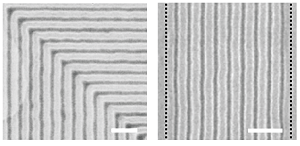Sep 8 2016
 Scanning electron micrographs of block copolymer films assembled on graphene/germanium chemical patterns with 90 degree bends (left side) and with density multiplication by a factor of 10 (right side). The black dotted lines (right side) indicate the period of the graphene/germanium chemical pattern, in which the period of the assembled block copolymer is reduced by a factor of 10 due to density multiplication. The scale bars are 200nm. (University of Wisconsin–Madison)
Scanning electron micrographs of block copolymer films assembled on graphene/germanium chemical patterns with 90 degree bends (left side) and with density multiplication by a factor of 10 (right side). The black dotted lines (right side) indicate the period of the graphene/germanium chemical pattern, in which the period of the assembled block copolymer is reduced by a factor of 10 due to density multiplication. The scale bars are 200nm. (University of Wisconsin–Madison)
Manufacturers of computer chips constantly aim to pack more transistors into less space, however with the size of those transistors nearing the atomic scale, there are physical limitations on how small they are able to make the circuitry’s patterns.
Using a germanium wafer coated with a layer of nearly pristine graphene, a team of researchers from the University of Wisconsin–Madison and the University of Chicago have developed a simpler, reproducible, and low-cost manufacturing method using directed self-assembly.
As a large-scale, nano-patterning method, directed self-assembly can raise the density of circuit patterns and circumvent certain drawbacks of conventional lithographic methods used for printing circuits on wafers of semiconductors such as silicon.
Electrical engineer Zhenqiang “Jack” Ma and materials engineer Michael Arnold of University of Wisconsin–Madison, chemical engineer Paul Nealey of the University of Chicago, and their students published their findings in the August 16 edition of the Scientific Reports journal.
Their research could enhance the capacity for data storage and in functionality for semiconductor electronics.
To achieve the extremely small size needed for the circuitry in advanced semiconductor electronics, manufacturers are developing directed self-assembly, which enables the fabrication of complex, flawlessly ordered polymer patterns for circuitry.
For directed self-assembly, the team uses conventional chemical methods to describe a pre-pattern. When chains of molecules called as block copolymers self-assemble on the pre-pattern, they trail the pattern to form flawlessly-ordered features.
The new technique is much quicker, and decreases the number of process steps to just two - plasma etching and lithography.
During the first display of their methods, the research team used electron beam lithography and a mild plasma etching method to pattern one-atom-thick graphene stripes on a germanium wafer. The wafer was then spin-coated using a basic block copolymer known as polystyrene-block-poly (methyl methacrylate).
Compared to conventional chemical patterns, when heated, the block copolymer self-assembled fully within 10 minutes instead of 30 minutes and with fewer defects. The researchers credit this quick assembly to the smooth, stiff, crystalline surfaces of graphene and germanium.
Their new technique exploits a phenomenon known as density multiplication. The team used electron beam lithography to primarily develop a larger master template with sparse patterns that direct the orientation of their block copolymers.
They guided the block copolymer to self-assemble. The manner in which it self-assembled improved the resolution of the original template - in this case, by a factor of 10. In the past, the best enhancement using density multiplication was a factor of four.
While the stripe pattern was a simple exhibition of their method, the team also demonstrated that it works with more architecturally intricate or irregular patterns, including those with unexpected 90-degree bends.
These templates offer an exciting alternative to traditional chemical patterns composed of polymer mats and brushes, as they provide faster assembly kinetics and broaden the processing window, while also offering an inert, mechanically and chemically robust, and uniform template with well defined and sharp material interfaces.
Paul Nealey, Chemical Engineer, University of Chicago
The method enables them to merge the consistency and simpler processing of conventional “top-down” lithographic techniques with the benefits of “bottom-up” assembly and greater density multiplication, and offers a potential path for large-scale production at considerably decreased cost.
“Using this one-atom-thick graphene template has never been done before. It’s a new template to guide the self-assembly of the polymers,” says Ma. “This is mass-production-compatible. We opened the door to even smaller features.”
The researchers are patenting their technique through the Wisconsin Alumni Research Foundation. The research was funded from the U.S. departments of Energy and Defense, UW–Madison and the University of Chicago.
Other authors on the paper include Tzu-Hsuan Chang, Robert M. Jacobberger, Solomon Mikael, Dalong Geng and Xudong Wang of UW–Madison, and Shisheng Xiong, Hyo Seon Suh and Chi-Chun Liu of the University of Chicago.